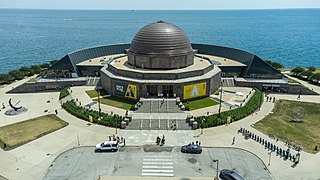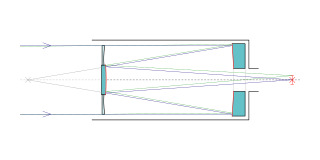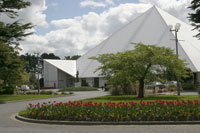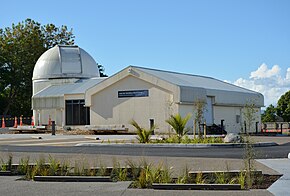
Subaru Telescope is the 8.2-metre (320 in) telescope of the National Astronomical Observatory of Japan, located at the Mauna Kea Observatory on Hawaii. It is named after the open star cluster known in English as the Pleiades. It had the largest monolithic primary mirror in the world from its commissioning until the Large Binocular Telescope opened in 2005.

The Adler Planetarium is a public museum in Chicago, Illinois, dedicated to astronomy and astrophysics. It was founded in 1930 by local businessman Max Adler. Located on the northeastern tip of Northerly Island on Lake Michigan, the Adler Planetarium was the first planetarium in the United States. It is part of Chicago's Museum Campus, which includes the John G. Shedd Aquarium and The Field Museum. The Planetarium's mission is to inspire exploration and understanding of the universe.
Boyden Observatory is an astronomical research observatory and science education centre located in Maselspoort, 20 kilometres (12 mi) north-east of the city of Bloemfontein in Free State, South Africa. The observatory is managed by the Physics Department of the University of the Free State (UFS). The Friends of Boyden assist the observatory as a public support group, organising open evenings and protecting its public interest. Boyden also makes use of members of ASSA Bloemfontein Centre, the amateur astronomy club of the city, for presenters and telescope assistants.

The Cerro Tololo Inter-American Observatory (CTIO) is an astronomical observatory located on the summit of Mt.Cerro Tololo in the Coquimbo Region of northern Chile, with additional facilities located on Mt. Cerro Pachón about 10 kilometres (6.2 mi) to the southeast. It is approximately 80 kilometres (50 mi) east of La Serena, where support facilities are located. The site was identified by a team of scientists from Chile and the United States in 1959, and it was selected in 1962. Construction began in 1963 and regular astronomical observations commenced in 1965. Construction of large buildings on Cerro Tololo ended with the completion of the Víctor Blanco Telescope in 1974, but smaller facilities have been built since then. Cerro Pachón is still under development, with two large telescopes inaugurated since 2000, and one in the final stages of construction as of 2023

Stardome Observatory is a public astronomical observatory situated in Maungakiekie/One Tree Hill Domain in Auckland, New Zealand.

The Kopernik Observatory & Science Center (KOSC), is a public observatory in Vestal, New York opened to the public on 16 June 1974 by the Kopernik Society of Broome County to commemorate the 500th anniversary of the birth of the astronomer Nicolaus Copernicus in 1973. Its mission is to offer hands-on investigations and outreach programs for educating all ages about astronomy and science using advanced optical telescopes, computers and other tools. It is the first science laboratory facility in New York State designed for K-12 teachers, students and their families, and has been one of the best-sited and best equipped public observatories in the Northeast United States for nearly the last 40 years.

Goldendale Observatory State Park is an educational facility on the northern side of Goldendale, Washington, notable for its unusually large public telescope. The state park occupies five acres (2.0 ha) atop a 2,100-foot (640 m) hill.

Space Place at Carter Observatory is an observatory in Wellington, New Zealand, located at the top of the Wellington Botanic Garden.

The Schmidt–Cassegrain is a catadioptric telescope that combines a Cassegrain reflector's optical path with a Schmidt corrector plate to make a compact astronomical instrument that uses simple spherical surfaces.
C. E. K. Mees Observatory is an astronomical observatory in Bristol, New York, owned and operated by the University of Rochester. The observatory is named after C. E. Kenneth Mees, "in honor of his pioneering work in the development of sensitive photographic emulsions for use in astronomy."
Naylor Observatory is an astronomical observatory owned and operated by Astronomical Society of Harrisburg. It is located near Lewisberry, Pennsylvania, United States.

The Heights School is a combined secondary and primary school serving the Modbury Heights area in Adelaide, South Australia. It is located in Adelaide's District 5 school district, in close proximity to Golden Grove High School, Gleeson College and Pedare Christian College.
Southland Astronomical Society Observatory in Invercargill is New Zealand's southernmost observatory. Operated by Southland Astronomical Society but owned by the Southland Museum and Art Gallery, it is situated on the western side of the museum building.

Mills Observatory is the first purpose-built public astronomical observatory in the UK, located in Dundee, Scotland. Built in 1935, the observatory is classically styled in sandstone and has a distinctive 7 m dome, which houses a Victorian refracting telescope, a small planetarium, and display areas. The dome is one of two made from papier-mâché to survive in the UK, the other being at the Godlee Observatory.

The Heights Observatory is an Astronomical Observatory at The Heights School in Modbury Heights, Adelaide, South Australia.

Optical Mechanics, Inc. or OMI is a high-end American telescope and optics instrument manufacturer. OMI was founded in 2002 and produces observatory telescopes, Lidar telescopes, optical tube assemblies, telescope mirrors and reflective coatings for mirrors. OMI mirrors are used by other telescope makers such as Obsession Telescopes. Also taking on custom projects, they produced the 48-inch Dob, a 48.875-inch-diameter (1,241.4 mm) aperture, f/4, Dobsonian telescope called "Barbarella" and featured in Astronomy Technology Today magazine. OMI is located in the US state of Iowa. OMI procured the assets of the former optics company Torus Technologies. OMI has an optics shop where it does work on telescopes.
The SUNY Oneonta Observatory is an astronomical observatory in Oneonta, New York, home to the state's largest optical telescope and one of the largest publicly open east of the Mississippi, a one-meter Newtonian reflector constructed by JMI Telescopes of Lakewood, Colorado.
The Von Braun Astronomical Society is a society of amateur and professional astronomers dedicated to education and public outreach on behalf of astronomy based in Huntsville, Alabama, United States.

The Southland Astronomical Society is the southernmost astronomical society in the world. Based in Invercargill at the southern tip of New Zealand's South Island, its small, active group of about 36 amateur astronomer members participate in a variety of astronomical activities including education with groups and school children, deep sky observing, astrophotography and aurora observation.
The Whakatane Astronomical Society is a voluntary, non-profit society for people interested in amateur astronomy in the Whakatane District of New Zealand. The society was founded in September 1960, and maintains a small observatory in Whakatane, which has been operating continuously since 1964. The society is affiliated with the Royal Astronomical Society of New Zealand.














